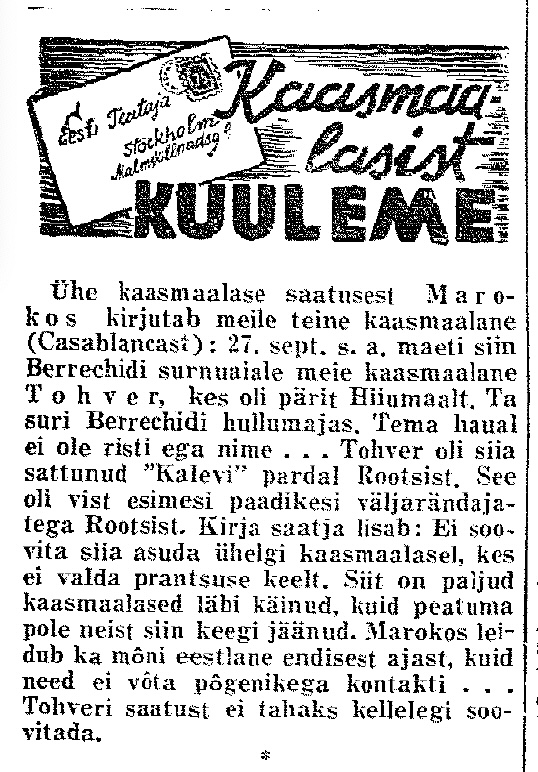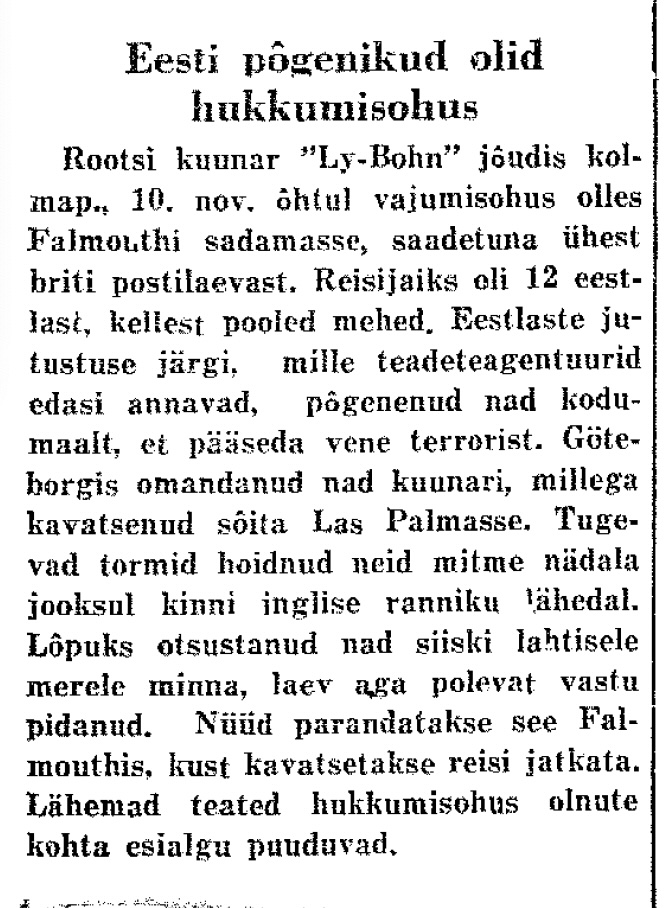Boats
Other Broken Journeys
–On October 31, 1946, the New York Times reported, “A group of seventeen Latvians and Lithuanians claiming to be ‘refugees from the Russians,’ landed in Northumberland last night. Their 40-foot fishing boat broke down six miles off the British coast after a 10-day voyage from Sweden and they were towed to shore.” It is not known what happened to the refugees.

Eesti Teataja, October 10, 1948
–In 1946, the Kalev left Sweden with 13 refugees on board. According to one account, the fishing boat arrived in the Danish port of Hirtshals in June 1946, with eight men, four women, and a 15-month child on board. A few months later on October 5, a notice from Kinsale, Ireland, reported that the boat’s captain, Verner Väli, and eight Estonian refugees left that day for Santo Domingo in the Dominican Republic. Two years later, on October 10, 1948, Eesti Teataja reported the sad fate of “our compatriot Tohver from Hiiumaa” who had arrived on the Kalev. He died in a “madhouse” in Berrechid, Morocco, and was buried in an unmarked grave (see article).
–Voldemar Kures, an Estonian journalist who wrote under the pseudonym “Fakt,” published an article in Stockholms-Tidningen Eestlastele on Jun 8, 1947, about an interview with Toivo Sillaots, secretary of the Estonian Seamen’s Welfare bureau. Sillaots told him that a seaman named Karl Tammer, a mechanic on the Swedish freighter Fylgia (not a Viking ship), had sent him a letter about visiting Liverpool the previous summer where he had met an Estonian and a Czech who planned to sail from Sweden to Brazil but only made it as far as England, where they sold their yacht and “lived a beautiful, fun life” in Liverpool. Tammer also wrote that in November 1946, he met two Estonians in Casablanca, and in March 1947 met two more in Las Palmas who may have come from the Kalev and Elvi. But this cannot be confirmed since no names were listed.

Eesti Teataja, November 14, 1948
–Nearly all of the boats left from Sweden but in 1949, Volker Harpe, 20, and Helmuth Russow, 38, escaped from the Russian Zone in Germany on the Felicitas (Filicius), a homemade 33-foot-long (10.07 meter) yacht. The men, who referred to themselves as Estonians in the U.S. press (they were of Baltic German heritage), planned to sail to Canada. After five weeks at sea, however, the mast of their yacht broke in a storm and the outboard motor died. The men drifted helplessly in the Atlantic until July 4, 1949, when the captain of the Britannic, a British steamship, rescued them 750 nautical miles west of Ireland. The men landed in New York on July 9 and were detained on Ellis Island for six months before being paroled. In 1951, they were granted permission to remain in the United States and lived there for the rest of their lives.
–Other reports of Viking boats offer even fewer details. The book Eestlased Kanadas mentions that nine men from an unnamed Viking boat drowned in the Bay of Biscay. Stockholms-Tidningen Eestlastele reported on January 9, 1949, that two refugee boats in the Bay of Biscay sank during storms, with no survivors. And on March 3, 1950, the Baltimore Sun published a long article about the Baltic refugees who had arrived in the United States since 1945. In addition to the known refugee ships, the article reported that eight people in a boat had landed in Miami in June 1949, but provided no further information. It also noted that three people had reached San Juan, Puerto Rico, on November 1, 1947. One drowned while landing, and the other two left the area. Additional details were not provided.
